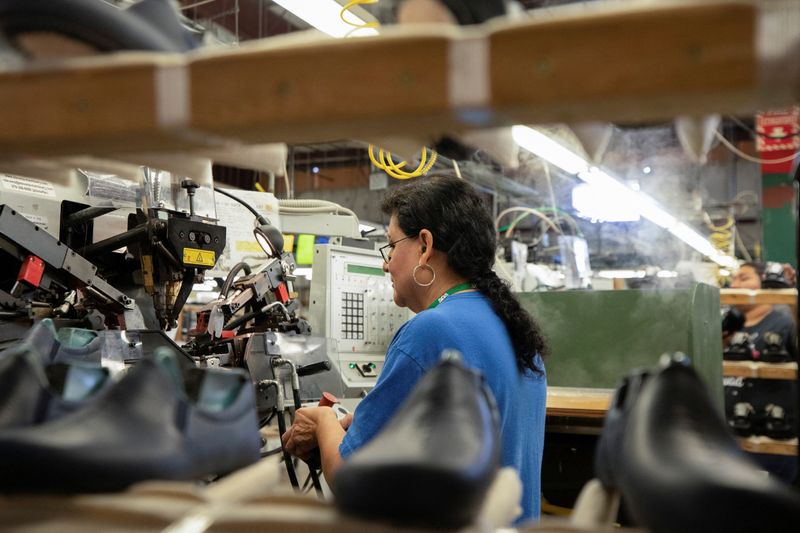Column-Global manufacturers struggle to regain momentum: Kemp
2024.01.05 11:34

© Reuters. FILE PHOTO: A woman works on the interior mould of a shoe at the San Antonio Shoe Factory in Del Rio, Texas, U.S., April 3, 2023. REUTERS/Kaylee Greenlee Beal/File Photo
By John Kemp
LONDON (Reuters) – U.S. manufacturers are still struggling to emerge from the prolonged slump that began in the middle of 2022 as the pandemic-driven surge in merchandise buying subsided and consumers reverted to spending on services.
Merchandise inventories have begun to normalise but companies making expensive business equipment and consumer durables are being hit by the high borrowing costs resulting from the biggest increases to interest rates for four decades.
U.S. manufacturers reported a decline in business activity for a 14th month in a row in December, the longest business cycle slowdown since the recessions in 2001 and early Nineties.
The Institute for Supply Management’s (ISM) purchasing managers index increased marginally to 47.4 (17th percentile for all months since 1980) from 46.7 (14th percentile) in October.
But the index has been below the 50-point threshold that divides expansion from contraction since November 2022.
The number of months below the threshold has had more in common with a cycle-ending recession (generally 11 months or more) than a mid-cycle slowdown (typically 10 months or fewer).
Chartbook: U.S. manufacturing activity
The slowdown appears to be prolonged but unusually shallow. Manufacturing output has been essentially flat for about a year, according to separate data compiled by the Federal Reserve.
Flat-lining manufacturing is confirmed by data on sales of diesel and other distillate fuel oils used by manufacturers and freight hauliers, which have also been flat or marginally lower for a year.
Distillate fuel oil consumption was level or slightly lower throughout the first 10 months of 2023 whether biofuels are included or not.
However, in a sign the trough has passed and renewed growth is imminent, the ISM production sub-index has been above 50 points in three of the most recent four months.
The new orders sub-index remains in negative territory but has been edging up towards 50 as excess inventory liquidation is completed and customers start confirming new business.
MANUFACTURERS LEAD DISINFLATION
The industrial recession has been significantly longer and deeper in Europe and China.
In the eurozone, the manufacturing purchasing managers index (PMI) has been below 50 points for 18 months running and finished the year at only 44.4 (8th percentile for all months since 2006) in December.
In China, the official manufacturing purchasing index has been below 50 points for 16 of the past 22 months and finished the year at 49.0 (5th percentile for all months since 2011).
The global industrial recession has depressed cross-border merchandise trade and taken much of the heat out of freight rates (until recent attacks on shipping in the Red Sea).
But it has also stifled growth in oil, gas and electricity consumption, relieving some of the pressure on stretched energy systems.
Downward pressure on prices for merchandise, freight and energy have driven most of the deceleration in inflation across major economies over the past year.
Higher interest rates have had a differential effect, with a greater and more immediate impact on the merchandise side of the economy than with services.
If the industrial slowdown persists, decelerating inflation should eventually create space for the U.S. central bank and its counterparts to start cutting interest rates over the course of 2024.
The major sources of uncertainty are what happens if lower rates cause merchandise spending to recover and tighten supply chains again, and what happens if the much stickier service sector inflation persists.
There is not much spare capacity in the energy system to facilitate faster growth (diesel inventories are low across all major consuming economies and the United States in particular).
Increases to labour market turnover and pay have decelerated but unemployment remains unusually low, suggesting there is not much slack if hiring picks up.
The challenge for major central banks is how far and how fast to cut interest rates without rekindling inflation.
Interest rate traders expect the Fed to cut rates by a quarter of a point at its March 19-20 meeting and then reduce them by five more quarter-points by the end of the year.
Such aggressive easing will only be possible if economic growth and goods sector growth are sluggish.
The dour outlook for manufacturing explains why oil prices have continued to slide even as traders bet on earlier, more aggressive rate cuts and Saudi Arabia and its OPEC+ allies try to support them by trimming output.
Related columns:
– U.S. manufacturing slowdown long but shallow (December 5, 2023)
– U.S. manufacturing has plateaued after post-pandemic rebound (November 13, 2023)
– Prolonged U.S. manufacturing slowdown barely dents energy use (September 5, 2023)
John Kemp is a Reuters market analyst. The views expressed are his own. Follow his analysis on X








